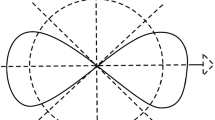Abstract
The linearized Poincaré map of a periodic orbit of a completely integrable Hamiltonian system is examined in the light of the finer description we get by using coordinate changes in the Lagrangian odd symplectic group. In particular, we obtain non-eigenvalue invariants called moduli. These invariants are surprisingly subtle to calculate even in the case of the geodesic flow on a 2-sphere, and reveal dynamic-geometric information that is otherwise symplectically invisible.
Similar content being viewed by others
Availibility of data and materials
No data used in submitted paper.
Notes
The action is by conjugation on the space of symplectic matrices.
References
Burgoyne, N., Cushman, R.: Conjugacy classes in linear groups. J. Algebra 44, 339–362 (1977)
Bates, L., Cushman, R.: The odd symplectic group in geometry. Int. J. Pure Appl. Math. 17, 1–8 (2004)
Bates, L., Cushman, R.: Applications of the odd symplectic group to Hamiltonian systems. Reg. Chaotic Dyn. 17, 2–16 (2011)
Do Carmo, M.: Differential geometry of curves and surfaces. Prentice-Hall Inc, Englewood Cliffs, N.J (1976)
Stoker, J.: Differential Geometry. Wiley, New York (1969)
Cushman, R.: Adjoint orbits of the odd symplectic group. Reg. Chaotic Dyn. 12, 744–753 (2007)
Funding
None.
Author information
Authors and Affiliations
Corresponding author
Ethics declarations
Conflict of interest
The authors declare that they have no conflict of interest.
Code Availibility
No computer code used in submitted paper.
Additional information
Publisher's Note
Springer Nature remains neutral with regard to jurisdictional claims in published maps and institutional affiliations.
Appendix
Appendix
As we do not know the Hamiltonian H as an explicit function of the actions \(j_1\) and \(j_2\) we compute the necessary partial derivatives of H as follows. Since
is a period integral, we may differentiate under the integral sign to obtain
Again differentiating under the integral sign gives
Similarly, \(\left. \frac{\partial ^2 J_1}{\partial h\partial j_2} \right| _{j_2=0} = 0\) as well. Finally,
Using the chain rule we get
Evaluating on the energy level \(h=\frac{1}{2}\) we get
Hence the linearized return map \({\mathcal {P}}_p\) is
Note that \({\mathcal {P}}_p\) is in normal form for the odd symplectic group. This normal form is different than the normal form for the equatorial case, since it is a unipotent matrix with two indecomposable blocks each having a nonzero modulus.
Rights and permissions
About this article
Cite this article
Bates, L., Cushman, R. Two Action-Angle Surprises on the Sphere. Qual. Theory Dyn. Syst. 20, 11 (2021). https://doi.org/10.1007/s12346-020-00438-6
Received:
Accepted:
Published:
DOI: https://doi.org/10.1007/s12346-020-00438-6




